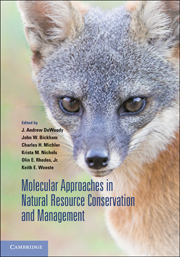Book contents
- Frontmatter
- Contents
- Contributors
- Preface
- 1 Biodiversity discovery and its importance to conservation
- 2 Gene flow, biodiversity, and genetically modified crops: Weedy rice in Thailand
- 3 A community and ecosystem genetics approach to conservation biology and management
- 4 Vertebrate sex-determining genes and their potential utility in conservation, with particular emphasis on fishes
- 5 Historical and contemporary dynamics of adaptive differentiation in European oaks
- 6 Association genetics, population genomics, and conservation: Revealing the genes underlying adaptation in natural populations of plants and animals
- 7 Hybridization in threatened and endangered animal taxa: Implications for conservation and management of biodiversity
- 8 Pollen and seed movement in disturbed tropical landscapes
- 9 Implications of landscape alteration for the conservation of genetic diversity of endangered species
- 10 Integrating evolutionary considerations into recovery planning for Pacific salmon
- 11 Using molecular methods to improve the genetic management of captive breeding programs for threatened species
- 12 Wildlife reintroductions: The conceptual development and application of theory
- 13 Evolutionary toxicology
- Index
- Plates
- References
8 - Pollen and seed movement in disturbed tropical landscapes
Published online by Cambridge University Press: 05 July 2014
- Frontmatter
- Contents
- Contributors
- Preface
- 1 Biodiversity discovery and its importance to conservation
- 2 Gene flow, biodiversity, and genetically modified crops: Weedy rice in Thailand
- 3 A community and ecosystem genetics approach to conservation biology and management
- 4 Vertebrate sex-determining genes and their potential utility in conservation, with particular emphasis on fishes
- 5 Historical and contemporary dynamics of adaptive differentiation in European oaks
- 6 Association genetics, population genomics, and conservation: Revealing the genes underlying adaptation in natural populations of plants and animals
- 7 Hybridization in threatened and endangered animal taxa: Implications for conservation and management of biodiversity
- 8 Pollen and seed movement in disturbed tropical landscapes
- 9 Implications of landscape alteration for the conservation of genetic diversity of endangered species
- 10 Integrating evolutionary considerations into recovery planning for Pacific salmon
- 11 Using molecular methods to improve the genetic management of captive breeding programs for threatened species
- 12 Wildlife reintroductions: The conceptual development and application of theory
- 13 Evolutionary toxicology
- Index
- Plates
- References
Summary
INTRODUCTION
A characteristic of modern landscapes worldwide is that continuous habitats have become, largely due to human activities, mosaics of remnant habitat fragments embedded in an urban or agricultural matrix (see Chapter 9 by Leberg and colleagues). Landscape fragmentation can have distinct ecological (e.g., species extinction), demographic (e.g., lowered reproduction and elevated mortality), and genetic (e.g., less genetic diversity and increased inbreeding) consequences. In northern temperate regions, human impacts on natural landscapes date back several thousand years but, in most tropical landscapes, widespread human disturbance is more recent, with the heaviest impacts occurring during the last fifty years. Disturbance and fragmentation of once continuous habitats can have immediate, short-term, and long-term consequences for the management and conservation of genetic diversity within tropical plant species.
Immediate consequences
Landscape fragmentation has immediate consequences for the levels and distribution of genetic diversity that are not dependent on population genetic processes acting across subsequent generations. Three factors can have immediate effects on the genetic composition of fragmented populations: 1) the proportion of the original population that is removed, 2) the number of individuals that survive in each fragment, and 3) patterns of genetic variation present within natural populations prior to fragmentation (e.g., clusters of related individuals).
- Type
- Chapter
- Information
- Publisher: Cambridge University PressPrint publication year: 2010
References
- 7
- Cited by



